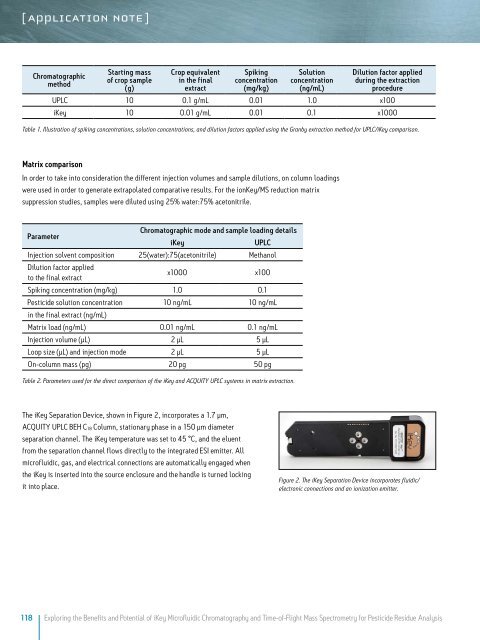ionkey/MS
1TDCbKs
1TDCbKs
Create successful ePaper yourself
Turn your PDF publications into a flip-book with our unique Google optimized e-Paper software.
Chromatographic<br />
method<br />
Starting mass<br />
of crop sample<br />
(g)<br />
Crop equivalent<br />
in the final<br />
extract<br />
Spiking<br />
concentration<br />
(mg/kg)<br />
Solution<br />
concentration<br />
(ng/mL)<br />
Dilution factor applied<br />
during the extraction<br />
procedure<br />
UPLC 10 0.1 g/mL 0.01 1.0 x100<br />
iKey 10 0.01 g/mL 0.01 0.1 x1000<br />
Table 1. Illustration of spiking concentrations, solution concentrations, and dilution factors applied using the Granby extraction method for UPLC/iKey comparison.<br />
Matrix comparison<br />
In order to take into consideration the different injection volumes and sample dilutions, on column loadings<br />
were used in order to generate extrapolated comparative results. For the ionKey/<strong>MS</strong> reduction matrix<br />
suppression studies, samples were diluted using 25% water:75% acetonitrile.<br />
Parameter<br />
Chromatographic mode and sample loading details<br />
iKey<br />
UPLC<br />
Injection solvent composition 25(water):75(acetonitrile) Methanol<br />
Dilution factor applied<br />
to the final extract<br />
x1000<br />
x100<br />
Spiking concentration (mg/kg) 1.0 0.1<br />
Pesticide solution concentration 10 ng/mL 10 ng/mL<br />
in the final extract (ng/mL)<br />
Matrix load (ng/mL) 0.01 ng/mL 0.1 ng/mL<br />
Injection volume (μL) 2 μL 5 μL<br />
Loop size (μL) and injection mode 2 μL 5 μL<br />
On-column mass (pg) 20 pg 50 pg<br />
Table 2. Parameters used for the direct comparison of the iKey and ACQUITY UPLC systems in matrix extraction.<br />
The iKey Separation Device, shown in Figure 2, incorporates a 1.7 µm,<br />
ACQUITY UPLC BEH C18 Column, stationary phase in a 150 μm diameter<br />
separation channel. The iKey temperature was set to 45 °C, and the eluent<br />
from the separation channel flows directly to the integrated ESI emitter. All<br />
microfluidic, gas, and electrical connections are automatically engaged when<br />
the iKey is inserted into the source enclosure and the handle is turned locking<br />
it into place.<br />
Figure 2. The iKey Separation Device incorporates fluidic/<br />
electronic connections and an ionization emitter.<br />
118 Exploring the Benefits and Potential of iKey Microfluidic Chromatography and Time-of-Flight Mass Spectrometry for Pesticide Residue Analysis


